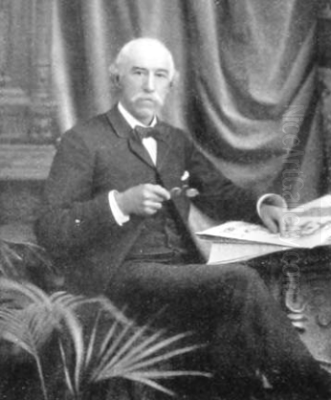
Robert Spear Dunning stands as a significant figure in nineteenth-century American art, celebrated particularly for his exquisite still life paintings. An artist whose meticulous technique and keen eye for detail captured the lushness of nature and the refined objects of domestic life, Dunning carved a distinct niche for himself and influenced a regional school of painters. His journey from humble beginnings to a respected position in the art world is a testament to his dedication and innate talent. This exploration delves into his life, artistic development, signature style, key works, and his place within the broader context of American art history, acknowledging his connections and contributions alongside his contemporaries.
Early Life and Formative Experiences
Born on January 2, 1829, in Brunswick, Maine, Robert Spear Dunning's early life was not one steeped in artistic privilege. His family relocated to Fall River, Massachusetts, when he was a young child, around the age of five. Fall River, a burgeoning center of the textile industry, would become the backdrop for much of his life and career. Before dedicating himself to art, Dunning experienced the rigors of manual labor, working in a local cotton mill. This period of his youth was followed by a three-year stint at sea, an experience that, while not directly artistic, likely broadened his perspectives and perhaps instilled a discipline that would later serve his meticulous painting style.
Despite these early non-artistic pursuits, Dunning's inclination towards art was evident. The precise timeline of his earliest artistic endeavors is not fully documented, but it is clear that his passion for drawing and painting eventually led him to seek formal training. This decision marked a pivotal turn, setting him on a path to become one of New England's most accomplished still life painters. His formative years in an industrial town, coupled with his experiences in the mills and at sea, provided a contrasting foundation to the refined and often opulent subjects he would later choose for his canvases.
Artistic Training and Influences

Around 1849, at the age of twenty, Dunning made the significant move to New York City to pursue formal art education. He enrolled in the prestigious National Academy of Design, a central institution for American artists at the time. There, he studied under Daniel Huntington (1816-1906), a highly respected and versatile artist known for his portraits, historical scenes, and landscapes. Huntington, a former president of the National Academy, was a prominent figure whose tutelage would have provided Dunning with a strong academic grounding in drawing, composition, and painting techniques. Huntington himself was part of a lineage that included study with Samuel F.B. Morse (1791-1872) and Henry Inman (1801-1846), connecting Dunning to earlier traditions of American painting.
During his time in New York, Dunning initially focused on portraiture and figure painting, genres in which Huntington excelled. He also explored landscape and marine painting, perhaps drawing on his earlier experiences at sea. His works from this period began to be exhibited, with his first appearance at the National Academy of Design in 1850. He also exhibited at the American Art Union that same year, indicating early recognition of his developing skills. The artistic environment of New York, bustling with established and emerging talents, would have exposed Dunning to a wide range of styles and subjects, further shaping his artistic sensibilities.
While Dunning gained proficiency in various genres, it was after 1865, following his return to Fall River, that he increasingly dedicated himself to still life painting. This shift would define his mature career and secure his legacy. The meticulous realism and attention to detail fostered by his academic training under Huntington found a perfect outlet in the depiction of fruits, flowers, and carefully arranged objects.
The Ascendance of a Still Life Virtuoso
Robert Spear Dunning's true calling emerged in the realm of still life. His paintings in this genre are characterized by their remarkable realism, often verging on trompe l'oeil (French for "deceive the eye"). He possessed an extraordinary ability to render textures with convincing accuracy – the dewy bloom on a grape, the velvety skin of a peach, the cool sheen of silver, or the delicate translucence of a wine glass. His compositions were typically abundant, featuring lavish arrangements of fruit, often overflowing from baskets or bowls, sometimes accompanied by flowers, glassware, and fine tableware.
Dunning's still lifes often convey a sense of opulence and Victorian abundance, reflecting the prosperity of the era and the tastes of his patrons. He masterfully manipulated light and shadow to create a strong sense of volume and depth, making the objects appear almost tangible. The rich, often dark backgrounds he employed served to highlight the vibrant colors and intricate details of the primary subjects. His palette was rich and luminous, capturing the natural hues of his subjects with fidelity.
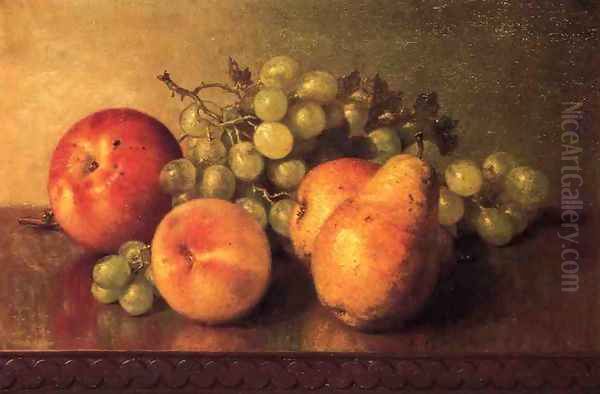
This dedication to realism was not merely for show; it was rooted in a deep appreciation for the beauty of the natural world and the craftsmanship of man-made objects. Artists like Raphaelle Peale (1774-1825) and James Peale (1749-1831) had earlier established a strong tradition of still life painting in America, and Dunning's work can be seen as a continuation and evolution of this legacy, particularly in its Victorian sensibility. He shared with painters like Severin Roesen (c. 1815-c. 1872), a German-American artist known for his elaborate fruit and flower still lifes, a love for profusion and intricate detail, though Dunning's compositions often felt more intimately arranged.
Masterworks and Signature Compositions
Several paintings stand out as exemplary of Robert Spear Dunning's skill and artistic vision. Among his most celebrated early still lifes is "Harvest of Cherries" (1866). This work depicts a bounty of glistening red cherries spilling from a woven basket, accompanied by a man's straw hat and a woman's overturned headscarf. The painting evokes a sense of rustic charm and romantic abundance, with the meticulously rendered cherries appearing almost edible. The play of light on the fruit and the varied textures of the basket, hat, and fabric showcase Dunning's technical prowess.
Another significant piece is "Still Life with Fruit" (1868). This painting, typical of his mature style, features a rich assortment of fruits – grapes, peaches, pears, and perhaps berries – arranged in a complex, yet harmonious composition. The objects are often set against a dark, atmospheric background, which makes the colors of the fruit appear even more vibrant. Dunning’s attention to the subtle variations in color and texture, the way light reflects off the surfaces, and the careful balance of forms are all hallmarks of his work.
His paintings often included elements of luxury, such as ornate silver compotes or delicate porcelain. "Still Life with Fruit and Roses" (specific year often varies or is unrecorded for some versions) is a title that represents a recurring theme, combining the ephemeral beauty of flowers with the luscious appeal of fruit. These compositions demonstrate his ability to balance natural beauty with man-made elegance, creating scenes that were both visually stunning and evocative of a comfortable, prosperous lifestyle.
While primarily known for still lifes, Dunning also produced landscapes, such as "Autumn at Medway" (1885). This work reveals his skill in capturing the atmospheric qualities and rich colors of the New England scenery, demonstrating a versatility beyond his primary genre. However, it is his still lifes that garnered the most acclaim and remain his most enduring legacy. His dedication to this genre was so profound that his work became almost synonymous with the "Fall River School" of still life painting.
The Fall River School and Dunning's Educational Role
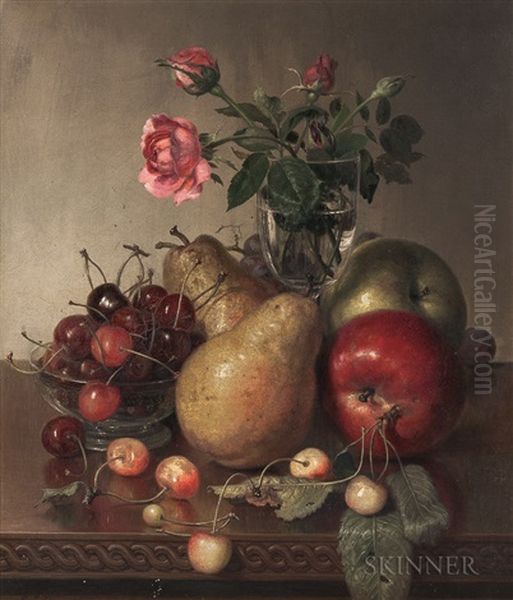
Robert Spear Dunning was not only a prolific painter but also an influential teacher. In 1870, he co-founded the Fall River Evening Drawing School with his friend and fellow artist, John E. Grouard (active late 19th century). This institution was unique for its time, especially in a smaller New England industrial city. The school became a hub for aspiring artists in the region and played a crucial role in fostering a local artistic tradition, often referred to as the "Fall River School" of painters.
The Fall River School, with Dunning as its leading figure, became particularly known for its highly realistic still life paintings, often in the trompe l'oeil style. Dunning's meticulous approach and his emphasis on direct observation and precise rendering heavily influenced the students and artists associated with the school. While Dunning himself was the most prominent, other artists from the area, or those who adopted a similar style, contributed to this regional artistic identity.
Artists like Edward Chalif Dimmick (1850-1880) from nearby Providence, Rhode Island, and Edward Leavitt (1842-1904), also from Providence and later Fall River, are sometimes associated with or compared to the Fall River aesthetic, though Leavitt's style was often considered more painterly than Dunning's photographic precision. Dunning's role as an educator ensured that his artistic principles were disseminated, creating a legacy that extended beyond his own canvases. He taught at the school for many years, contributing significantly to the cultural life of Fall River and nurturing a generation of local artists.
Dunning in the Context of 19th-Century American Art
To fully appreciate Robert Spear Dunning's contributions, it's important to place him within the broader context of 19th-century American art. The mid-to-late 19th century was a period of significant artistic development in the United States. The Hudson River School, with artists like Thomas Cole (1801-1848) and Asher B. Durand (1796-1886), had established landscape painting as a dominant genre, celebrating the American wilderness. Luminism, an offshoot characterized by its treatment of light and atmosphere, also flourished with artists such as Fitz Henry Lane (1804-1865) and Martin Johnson Heade (1819-1904), the latter also being a notable painter of floral still lifes and hummingbirds.
While landscape painting held a prominent position, still life painting also enjoyed considerable popularity, particularly among the growing middle and upper classes who sought art to adorn their homes. Dunning's work catered to this demand, offering images of abundance, refinement, and domestic tranquility. His meticulous realism aligned with a broader Victorian taste for detailed representation and verisimilitude.
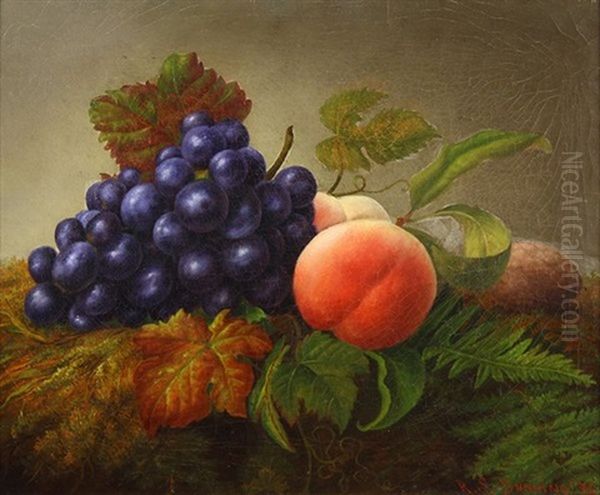
The trompe l'oeil tradition, which Dunning masterfully employed, saw a particular vogue in late 19th-century America with artists like William Michael Harnett (1848-1892) and John F. Peto (1854-1907). While Harnett and Peto often focused on masculine subjects like books, pipes, and hunting gear, Dunning's trompe l'oeil effects were typically applied to the more traditional still life subjects of fruit and flowers, imbuing them with an almost hyper-realistic presence. John Haberle (1856-1933) was another contemporary master of deception in painting, often focusing on currency and everyday objects.
Dunning's commitment to realism and his detailed finish can be contrasted with the emerging trends of Impressionism that began to influence American art towards the end of the century, championed by artists like Mary Cassatt (1844-1926) and Childe Hassam (1859-1935). Dunning remained largely faithful to his academic training and his established style, which continued to find favor with his patrons. His work represents a culmination of the detailed realism that was highly valued in American art before the widespread adoption of more modern, painterly approaches.
Exhibitions, Recognition, and Collections
Throughout his career, Robert Spear Dunning actively exhibited his work, gaining recognition in prominent artistic circles. As mentioned, he began showing at the National Academy of Design in 1850 and continued to exhibit there periodically until 1880. His participation in the American Art Union exhibition in 1850 also marked an early success. Furthermore, he exhibited at the Boston Art Club, another important venue for New England artists.
His paintings were sought after by collectors, and his reputation as a leading still life painter grew steadily. Today, Dunning's works are held in the collections of several prestigious American museums, affirming his historical importance. These include the Smithsonian American Art Museum in Washington, D.C., which holds pieces that showcase his characteristic style. The Fall River Historical Society in Massachusetts, naturally, has a significant collection, preserving the legacy of the city's most famous artist. His paintings can also be found in institutions such as the Museum of Fine Arts, Boston, the Columbus Museum in Georgia, and formerly in collections like that of the Pennsylvania Academy of the Fine Arts, reflecting a widespread appreciation for his artistry. The continued presence of his work in public and private collections underscores his lasting appeal and his contribution to the American still life tradition.
Later Years and Enduring Legacy
Robert Spear Dunning continued to paint and teach in Fall River for many years, remaining a respected figure in the local community and the broader New England art scene. He passed away on April 12, 1905, in Westport Harbor, Massachusetts, leaving behind a substantial body of work that continues to be admired for its technical brilliance and aesthetic charm.
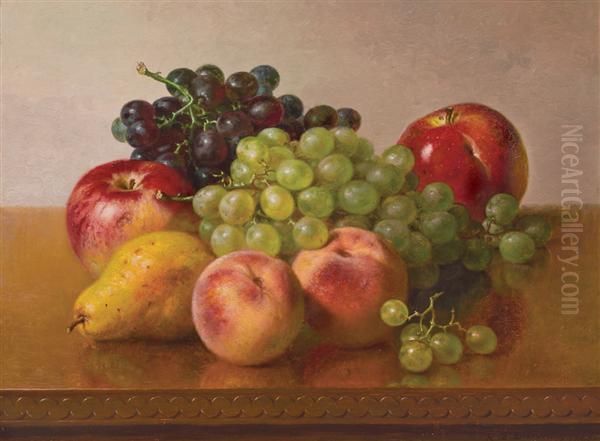
His legacy is multifaceted. As a painter, he achieved a level of realism in still life that few of his contemporaries could match. His ability to capture the essence of his subjects, from the bloom on a grape to the gleam of silver, was extraordinary. His compositions, while often traditional in their subject matter, were executed with a freshness and vitality that made them highly appealing.
As an educator and a central figure in the Fall River School, Dunning played a vital role in fostering artistic talent and creating a distinct regional artistic identity. He demonstrated that significant art could flourish outside major metropolitan centers, and his school provided opportunities for many aspiring artists.
In the annals of American art, Robert Spear Dunning is remembered as a master of still life, an artist who brought a unique blend of academic precision and Victorian sensibility to his chosen genre. His paintings offer a window into the tastes and aspirations of 19th-century America, celebrating the beauty of the everyday and the bounty of nature with unparalleled skill. His influence, particularly in New England, and the enduring appeal of his meticulously crafted canvases secure his place as an important contributor to the rich tapestry of American art history. His work continues to inspire admiration for its sheer technical skill and its quiet celebration of beauty.